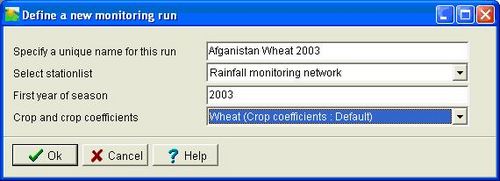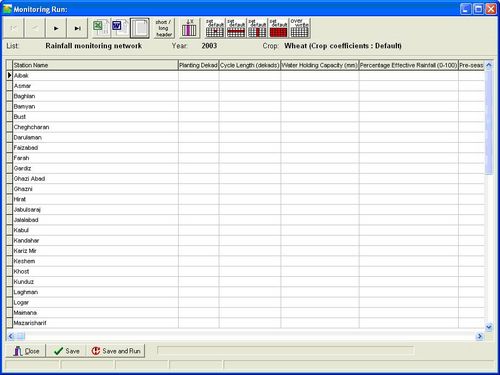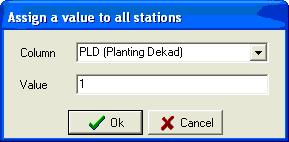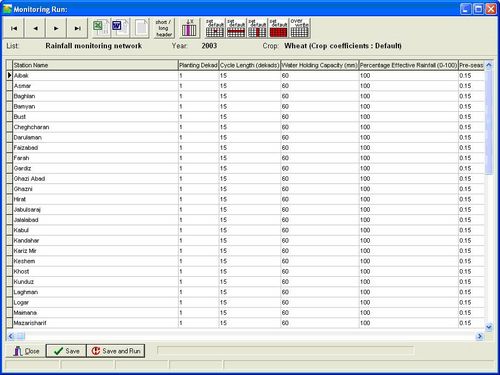[edit]6.2. Gathering all data into the FAO AgroMetShell crop simulation software.
Peter Hoefsloot
[edit]Entering data for a crop water balance calculation
Every model produces output based on input. The more accurate these data are, the more accurate the model outcome. To thus rule the FAO Water Balance Model is no exception. For a water balance calculation the following data are needed:
[edit]Weather data
- Actual Rainfall for the period of he water balance calculation (up to the current dekad). There are three ways to read these data into AgrometShell.
- Using the Database-Weather-Dekad function.
- When the data come as ASCII files, using the Database-Import-from ASCII file
- When the rainfall comes in the form of images (e.g. based on satellite imagery), it can be imported through the Database-Import-from image function.
- Normal Rainfall for 36 dekads in the year. These data are read into AgrometShell in the same way as actual rainfall.
- Actual ET0 data for the season up to the current dekad. The ET0 data can be calculated from its base data (temperatures, windpeed etc.. ) using the Database-Calculate-Formula function or the Tools-Potential ET-from file function. In case the ET0 values are already calculated, these data can be entered in the three ways mentioned above. Although actual ET0 data will improve the outcome of the water balance calculation, AgrometShell can calculate a water balance with normal values instead.
- Normal ET0 data for the season up to the current dekad. As outlined for actual data, the normal ET0 data can be either calculated or entered manually. The water balance calculation needs a full year of dekadal ET0 data to calculate the water balance.
- Irrigation amounts. This setting is important for use in irrigated rice simulations.
[edit]Crop data.
- Crops. Which crops are grown? Each crop has its own crop coefficients.
- Planting dekads. In which dekad planting occurred?
- Cycle length of the crops grown.
[edit]Soil related input data
- Water Holding Capacity of the soil.
- Percentage Effective Rainfall. This parameter is non-essential and is usually kept at 100%. It is meant to account for run-off (values lower than 100%) or run-on (values higher than 100%)
- Pre-season crop coefficient. This is the “crop” coefficient for bare soil (usually around 0.15).
[edit]Preparing a simple water balance calculation
After checking the availability of data a water balance can be prepared through the function Water Balance – Monitoring Run – New. Below as sample is given.
[edit]Refining the water Balance
In the previous section a very simple Water Balance calculation is completed. The same values have been assigned to the water balance parameters for all stations. In this paragraph the water balance calculation is made more realistic by calculating realistic planting dekads and adding irrigation.
[edit]Calculating planting dates
Measured values are always the best data around. So if planting dates are available it is advisable to use those. A good approximation of planting dates can be determined with rainfall records. Planting usually occurs as a result of rainfall exceeding a certain amount. AMS can calculate the planting dates based on this simple algorithm. Activate the Water Balance – Monitoring Run – Calculate planting dekads – Based on Rainfall Threshold function. In this example it is assumed that planting occurs when 20 millimeters of rainfall has been exceeded.

| CM Box User Guide | Main Page | About | Special pages | Log in |
Printable version | Disclaimer | Privacy policy |



